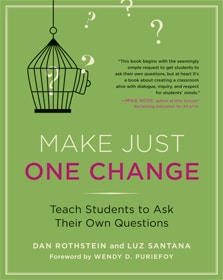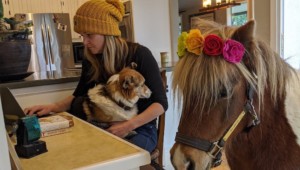Q&A: Dan Rothstein & Luz Santana On Make Just One Change
 Earlier this month, we reviewed Dan Rothstein and Luz Santana’s new book Make Just One Change: Teach Students to Ask Their Own Questions, a book that outlines the ways teachers can improve students’ ability to formulate effective questions for learning. This week, Rothstein and Santana have answered some additional questions for us about where the Question Formulation Technique™ (QFT™) originated and how it’s an ongoing discussion among educators today.
Earlier this month, we reviewed Dan Rothstein and Luz Santana’s new book Make Just One Change: Teach Students to Ask Their Own Questions, a book that outlines the ways teachers can improve students’ ability to formulate effective questions for learning. This week, Rothstein and Santana have answered some additional questions for us about where the Question Formulation Technique™ (QFT™) originated and how it’s an ongoing discussion among educators today.
Q: Where did the idea for the QFT originate?
A: The actual idea about the importance of people learning to ask their own questions emerged from work my Co-Author, Luz Santana, and I were doing as part of a dropout prevention program in Lawrence, MA, funded by the Annie E. Casey Foundation. Parents told us they were not participating in their children’s education because they didn’t even know what to ask.
We didn’t grasp it at the time, but the parents who were reluctant to set foot inside their children’s schools identified a huge obstacle that prevents many people from thinking for themselves, from doing their own problem solving, from becoming more self-sufficient and from being able to see the “Big Picture” beyond their own lives. It only took hearing that statement one or two…thousand times, and we finally got it.
Just as we finally grasped how important questions might be, we made a serious mistake. We came up with our own list of recommended questions and handed them to the parents. Very quickly, that turned into a dead end and only increased their dependency on us. Eventually, we figured out that we had to find a way to teach people how to formulate their own questions and to do it in a way that was accessible to all people.
For many years, the teaching of the skill, deliberately or indirectly, has often been limited to elite institutions or advanced professional educational programs. We’ve spent 15 years designing and testing ways to teach the skill as simply and effectively as possible and created the QFT. It has taken us a while but we’re excited that many people now describe it as the simplest, most powerful strategy available for helping people learn to think for themselves.
Q: What is the core message or principle of the book?
A: We just presented at a national conference of teachers, many of whom work hard at developing “essential” questions to stimulate student thinking. One teacher said after a workshop led by teachers using our strategy in their classrooms: “Students should learn to ask their own questions in every school in the country. It’s that simple and that important. It’s almost too obvious that it should be done and that may be why it’s not being done.” She eloquently and succinctly stated the core message of the book. We believe that, indeed, all students should learn how to ask their own questions. And, all teachers can easily make the teaching of the skill of question formulation a regular part of their on-going practice.
Q: What are some of the biggest challenges educators face when implementing the QFT with their students?
A: Most teachers are trained to ask questions of students. Using the QFT requires one very significant change: Instead of prompting students to think by prompting them with a question, the teacher needs to turn the questioning over to the student. That can be a shock to the system, for teacher as well as for student. At the same time, we work with teachers to see that they are still designing their lesson plans and are still giving direction to the learning process, but are using a “Question Focus” instead of a prompt, or question from the teacher.
The Question Focus (or what we call the QFocus) is an idea, challenge, concept, topic that is presented in a way similar to a prompt, but it turns the question generation process over to the students. Students can also learn to create their own QFocus which means that as they use more technology and drive their own learning more, they can become more sophisticated learners, identifying information they need more strategically and then more effectively gaining access to it.
Q: How have educators and students responded to the QFT?
A: Teachers, instructional coaches and district leaders talk about how they like that the QFT offers a structured and rigorous process while creating opportunities for student thinking. Reports from the classroom (from both teachers and students) document that when students use the process of the QFT they are more engaged, take more ownership of their own learning and learn more. Teachers report feeling more excited about teaching, and are struck by new energy in the room when the ‘heavy lifting’ of thinking is turned over to the students. They have also noticed that the rigor of a process that structures the interaction and discussion helps students learn to work more collaboratively in groups, and it allows for quieter students to also find their voice.
An experienced professional development coach has said that teachers using Project-Based Learning (PBL) often struggle with helping students generate a “driving question. The QFT” she said, “makes it possible for students to generate their own questions and figure out for themselves their ‘driving’ question.” There are many reports from classrooms in a wide range of communities confirming what Mike Rose observed about the examples in the book: “classrooms alive with dialogue, inquiry and respect for students’ minds.” The one change is small, but quite significant as Howard Gardner noted when he described it as leading to a “Copernican Revolution in the atmosphere of the classroom and the dynamics of learning.”
Q: In our conversations, we discussed the confusion between asking the “right or wrong questions.” How do you address this discussion with educators? Are some questions better than others? What do you feel makes a great question?
A: Teachers who are first introduced to the QFT worry a great deal that their students will ask “bad” questions, “wrong” questions or “lower-order” questions. As teachers go through the process for the first time themselves, they discover the value of students producing questions without, at first, categorizing or judging them. Students need an opportunity to go through a process in which they analyze, evaluate, change and prioritize their questions.
The QFT provides them with an opportunity to do more rigorous thinking about questions in one quick process than they’ve probably ever done in all their schooling. Once students are proficient at this, they become far more sophisticated in their ability to ask questions that go deeper, that open new ways of thinking, that allow them to make connections they had never made before. They get to those questions, which become fruitful questions, or, what can be considered “right” questions, only by having had the chance to ask many questions and tossing aside questions that seem less useful. The students, then, learn that there are some questions that are “wrong” in the sense that they can see that some of their initial questions won’t help them learn more, work on a research project, test a hypothesis, design a science experiment, or write an essay. They get to the “right” questions and that allows them to move forward.
There is not one definition of “right” or “wrong” question, but rather, students gain an understanding, developed through practice, about how to discern between different kinds and levels of questions. Turning that power over to the students, rather than leaving it with the teachers, is the key to developing self-directed learners.
Q: What piece of advice would you give to an educator working with students on the QFT?
A: The QFT has been extensively tested in a wide range of environments, in many communities and across many fields. It has been used by students from primary grades through graduate school, in urban, rural and suburban schools, public schools and private schools. Trust the process and be sure to refrain from giving examples of questions (no matter how much your students beg you to give one. It would stop students from doing the hard work of thinking for themselves). Use it once. Learn from implementation and then use it again and you’ll soon be an expert.
The book provides a comprehensive explanation of how teachers use the QFT in different classrooms and how it can be adapted to many age levels and subjects. Educators can also access additional resources on our website www.rightquestion.org. For more, view Make Just One Change: Teach Students to Ask Their Own Questions.
This Q&A was reviewed and edited by Sarah Cargill.




0 Comments
Leave a Comment
Your email address will not be published. All fields are required.